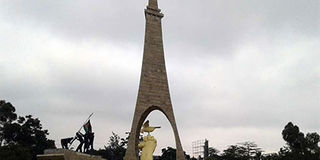The jewel of the city

National Monument at Uhuru Gardens. PHOTO| RUPI MANGAT
What you need to know:
- We trample through the narrow paths between grasses as tall as some of us. Fleur Ng’weno, who started these forays from in 1971, explains the importance of the grasslands. “Here is the place where two major habitats in Nairobi intersect,” she says.
- “One is the northern section which was the hilly part of Nairobi, which was all forest leading up to the farmlands and the Aberdares.
It was the coldest of days in Nairobi. A June Sunday with a sky pasted in white cloud dropping a fine drizzle. Being the third Sunday of the month, the Nature Kenya members set out to discover nature in and around Nairobi as we always do.
We decided to visit Uhuru Gardens National Monument in the very heart of Nairobi. It is here that a mugumo (fig) tree was planted on December 12, 1963, when the Union Jack was lowered at midnight and Kenya’s flag was raised to usher in ‘uhuru’ – freedom – from colonial rule.
Stepping out of the cars, with the cold and the fog hiding Nairobi’s ever-rising skyscrapers, the open fields of Uhuru Gardens look magical. Dewdrops hang on blades of grass like diamonds in a field. Uhuru Gardens is a jewel in the urban city. Apart from it being a national heritage site decked with three monuments, it’s a microcosm of a world before the city happened.
We trample through the narrow paths between grasses as tall as some of us. Fleur Ng’weno, who started these forays from in 1971, explains the importance of the grasslands. “Here is the place where two major habitats in Nairobi intersect,” she says. “One is the northern section which was the hilly part of Nairobi, which was all forest leading up to the farmlands and the Aberdares. The southern part, towards Nairobi National Park, had grasslands all the way to Kilimanjaro.”
At that point my imagination opens up to a Nairobi of more than a century ago that was a lush grassland and forest teeming with swamps and wildlife. The very word ‘Nairobi’ is derived from the Maa language – Nyarobe – for ‘a place of cool waters’ simply because it was like that.
We walk into the woodland of tall Yellow-barked acacia that leads to a wetland. Just at the edge there’s drama. A pair of predators swoop into the trees – it’s the Gabar goshawk – a small bird of prey that’s found in Africa and Arabia. With its short rounded wings and fairly long tail, it can fly in and out of trees easily.
Past the wetland in the woods, we follow the path that allows for a single file along the wall of the Gardens with the city’s traffic whizzing past along the Southern bypass. When a section of the gardens were hived off for the bypass, there was concern over one of the rarest plants that only surfaces in seasonal wetlands during the rains. It’s the Brachystelma lineare. It was carefully transferred to similar part of the gardens.
It’s why I love Nairobi. It’s a city that has what every other city has but with an extra edge: the last of the wild. By the end of the morning in the Gardens, we’ve listed 63 species of birds, plus warthogs, seen the spoor of mongoose and enjoyed interesting conversations with friends.
Grasslands are as important as indigenous forests because they are carbon sinks, water catchments and habitats for the wild. May Uhuru Gardens keep its green space for eternity.
www.rupitheafricantrotter.wordpress.com




